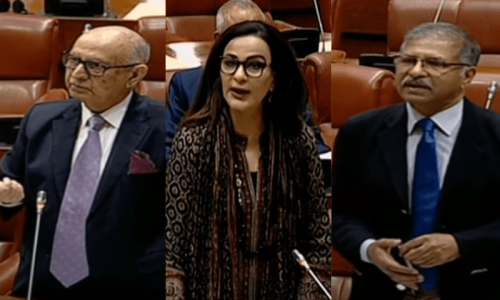
SUKKUR: Huge swarms of locusts continued to ravage green fields to destroy standing crops, vegetables and stocks of grains and fruits in many districts of Sindh but the aerial spray planned to be carried out jointly by the federal and provincial governments in a coordinated manner could not be started on a big scale.
The plan was agreed upon by the two governments about a month ago and several meetings had already been held in Islamabad to discuss procedural details for its implementation. Even funds have been earmarked and partially released to the relevant institutions, besides the provincial government.
As part of the plan, the machinery, equipment, gadgets and pesticides/chemicals have also reportedly been placed at the disposal of the institutions and department for ground operation. However, proper aerial spray to cover thousands of acres to eliminate the swarms — each comprising millions of locusts — is yet to be launched for one reason or the other.
Agriculturists and farmers, extremely anxious over the heavy losses they have been suffering every day fearing the worst in the weeks to come, believe that the aerial spray has been on the back burner only due to political differences over many other issues between the federal and Sindh governments.
The federal government has activated the National Disaster Management Authority (NDMA) to cope with the situation as many districts of all four provinces have also been hit by locusts.
In its latest statement issued in Islamabad on Sunday, the NDMA said that a total of 524,500 hectares of land in the affected parts of the country had been cleared of locusts in the ongoing operation. It said that the covered area includes 100 hectare in Sindh. However, it identified only three districts — Hyderabad, Matiari and Jamshoro — as the areas hit by locusts swarms.
The media has been reporting repeated attacks by locusts in upper, central and southern parts of Sindh over the last six months. The swarms are still there in several districts of upper Sindh.
All that has been seen so far in the name of aerial spray is that one aircraft landed at Sukkur airport about two weeks ago. It has remained unmoved since then for want of a pilot.
The federal government’s plant protection department and Sindh agriculture department have still been bickering over availability of required aircraft, fuel and essential machines, chemicals and manpower while the agriculture sector is suffering heavy losses.
According to the Rasool Bakhsh Junejo, director of agriculture department at Sukkur, the plant protection department was not responding to the repeated requests for provision of these things.
Plant protection department director Noor Ellahi Dashti says that one aircraft and pilot, as well as all other essentially required things including fuel and chemical had been provided to the Sindh government but aerial spray was not being carried out for reasons best known to the provincial authorities concerned.
He said locusts swarms were devouring green fields and agricultural produce on a big scale in the Sukkur region and had already destroyed crops and fodder grown over 8,000 acre or so.
He said ground operation was under way and around 200 acres in Salehpat, Kotdiji and Kashmore had already been cleared of locusts.
He argues that the aerial spray would become necessary only when an area of at least 500 square kilometres is affected by locusts.
Reports reaching here from Tharparkar on Sunday say that locust swarms had flown into various areas of the desert district and started devouring green pastures in Mubarak Rind, Gul Mohammad Rind and other areas of Chhachhro taluka.
Published in Dawn, June 8th, 2020













































